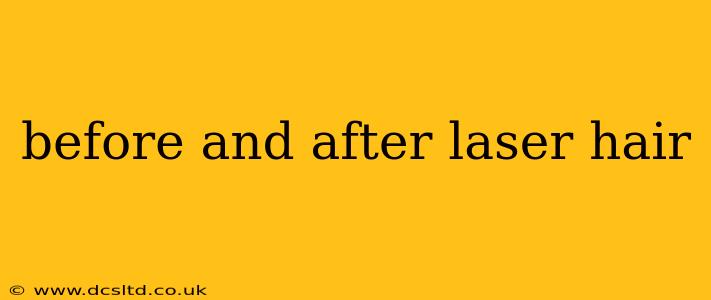Laser hair removal has become increasingly popular as a method for permanent hair reduction. But what can you realistically expect before, during, and after your treatments? Understanding the process thoroughly will help manage expectations and achieve the best possible results. This comprehensive guide will walk you through the entire journey, answering common questions and addressing concerns.
What Happens Before Laser Hair Removal?
Before your first session, a consultation with a qualified dermatologist or aesthetician is crucial. They will assess your skin type, hair color, and the area you want treated. This consultation is vital because it helps determine the suitability of laser hair removal for you and the best treatment plan. Factors like medications, sun exposure, and skin conditions will be considered. You'll likely be given specific pre-treatment instructions, which may include:
- Avoiding sun exposure: Sunburned or tanned skin is highly sensitive and can be damaged during laser treatment.
- Shaving the area: Avoid waxing, tweezing, or epilating the area before your appointment, as these methods remove the hair follicle's root, which is necessary for the laser to target. Shaving is usually preferred.
- Discontinuing certain medications: Some medications can increase your sensitivity to light and interfere with the treatment. Discuss any medications you're taking with your practitioner.
What Happens During Laser Hair Removal?
During the procedure, a laser emits a light beam that targets the melanin in your hair follicles. The melanin absorbs the light energy, which converts to heat and destroys the hair follicle. The process is generally quick and relatively painless, though some individuals may experience mild discomfort, described as a stinging or pinching sensation. A cooling gel or device is often used to minimize discomfort. The number of treatments needed varies depending on factors like hair color, skin type, and the area being treated.
What Happens After Laser Hair Removal?
The aftercare is just as important as the treatment itself. You can expect some temporary side effects, such as:
- Redness and swelling: This is normal and usually subsides within a few hours.
- Mild discomfort: Some tenderness or burning sensation might persist for a short time.
- Blistering or crusting (rare): In rare cases, more severe reactions like blistering or crusting may occur. This is usually a sign of improper treatment or neglect of aftercare instructions.
Following your practitioner's aftercare instructions is crucial: This usually involves keeping the treated area clean, avoiding sun exposure, and using recommended creams or lotions.
How Long Does It Take to See Results After Laser Hair Removal?
You won't see immediate results. It typically takes several weeks to see a noticeable reduction in hair growth. The full effects are usually seen after a course of treatments, typically spaced several weeks apart. The number of sessions needed varies depending on individual factors.
Is Laser Hair Removal Permanent?
It's crucial to understand that laser hair removal isn't truly permanent. It's more accurately described as "permanent hair reduction." While it significantly reduces hair growth, some hairs may regrow over time, particularly due to hormonal changes or other factors. Maintenance treatments might be necessary to keep hair growth at bay.
How Much Does Laser Hair Removal Cost?
The cost varies greatly depending on factors like the area treated, the number of sessions needed, and the clinic's pricing structure. It's essential to get a detailed quote from your chosen provider before starting treatment.
What Are the Risks and Side Effects of Laser Hair Removal?
While generally safe, laser hair removal carries some potential risks and side effects, including:
- Skin discoloration (hyperpigmentation or hypopigmentation): Changes in skin color can occur, but are usually temporary.
- Infection: Following proper aftercare instructions minimizes this risk.
- Burns: Improper technique or inappropriate laser settings can lead to burns. Choosing a qualified and experienced practitioner is crucial.
- Scarring: Scarring is rare, but it can occur.
How to Choose a Qualified Laser Hair Removal Provider?
Selecting a qualified and experienced practitioner is paramount. Look for practitioners with:
- Proper credentials and certifications: Ensure they have the necessary training and qualifications.
- Positive reviews and testimonials: Check online reviews to gauge the experiences of other clients.
- Use of advanced laser technology: Advanced lasers are often more effective and safer.
By following this comprehensive guide and carefully choosing your practitioner, you can significantly improve your chances of a successful and safe laser hair removal experience. Remember that open communication with your practitioner throughout the process is key to achieving optimal results.
